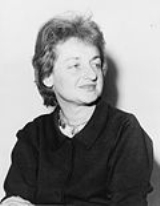
, activist, and feminist.
A leading figure in the Women's Movement
in the United States
, her 1963 book The Feminine Mystique
is often credited with sparking the "second wave" of American feminism in the twentieth century. In 1966, Friedan founded and was elected the first president of the National Organization for Women
, which aimed to bring women "into the mainstream of American society now [in] fully equal partnership with men".
In 1970, after stepping down as NOW's first president, Friedan organized the nation-wide Women's Strike for Equality
on August 26, the 50th anniversary of the Nineteenth Amendment to the United States Constitution
granting women the right to vote.
Men weren’t really the enemy — they were fellow victims suffering from an outmoded masculine mystique that made them feel unnecessarily inadequate when there were no bears to kill.![]()
We need to see men and women as equal partners, but it’s hard to think of movies that do that. When I talk to people, they think of movies of forty-five years ago! Hepburn and Tracy!![]()
The only way for a woman, as for a man, to find herself, to know herself as a person, is by creative work of her own. There is no other way.Interviews with Betty Friedan, Janann Sherman, ed. Univ. Press of Mississippi, 2002, ISBN 1578064805, p. x
: ISBN 0393322572
![]()
A girl should not expect special privileges because of her sex but neither should she 'adjust' to prejudice and discrimination. ![]()
The suburban housewife — she was the dream image of the young American women and the envy, it was said, of women all over the world. The American housewife — freed by science and labor-saving appliances from the drudgery, the dangers of childbirth, and the illnesses of her grandmother ... had found true feminine fulfilment.![]()
Strange new problems are being reported in the growing generations of children whose mothers were always there, driving them around, helping them with their homework — an inability to endure pain or discipline or pursue any self- sustained goal of any sort, a devastating boredom with life.![]()
Instead of fulfilling the promise of infinite orgastic bliss, sex in the America of the feminine mystique is becoming a strangely joyless national compulsion, if not a contemptuous mockery.![]()
Ch. 11 "The Sex-Seekers"
![]()
American housewives have not had their brains shot away, nor are they schizophrenic in the clinical sense. But if … the fundamental human drive is not the urge for pleasure or the satisfaction of biological needs, but the need to grow and to realize one’s full potential, their comfortable, empty, purposeless days are indeed cause for a nameless terror. ![]()

